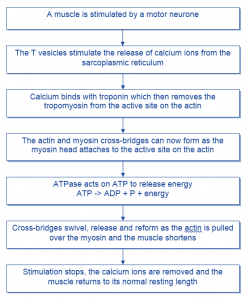More sliding filament theory
In slightly more detail…
The myosin filaments have small projections called myosin heads, which extend towards the actin but are not actually attached to it. When the nerve impulse is transmitted, the cross-bridges swivel towards the middle of the sarcomere, pulling the actin over the myosin and making the muscle shorter. The myosin head swivels and collapses and then reforms on another active site further along the actin, similar to a boat’s rowing motion, pulling the actin along the myosin towards the middle of the sarcomere. When the stimulus from the nerve stops, the muscle returns to its normal resting state.
All skeletal muscle reacts to an electrical stimulus, which is conducted from the brain to the muscle via nerves. The brain and spinal cord are referred to as the central nervous system, and nerves that carry information from the central nervous system to skeletal muscle are called motor or efferent nerves.
The myosin filaments have small projections called myosin heads, which extend towards the actin but are not actually attached to it. A protein called tropomyosin, bound to the active sites of the actin filament, prevents the myosin heads forming cross-bridges with the actin filament. Another protein bound to actin, troponin, can neutralise the effect of tropomyosin, but only in the presence of calcium. When the nerve impulse is transmitted down the transverse tubules/T viscles it stimulates the release of calcium from the sarcoplasmic reticulum. The troponin is then able to move the tropomyosin from the active site so that cross-bridges form between the myosin and the actin filament to produce actomyosin. Coupling of myosin stimulates the breakdown of ATP, releasing energy. The cross-bridges swivel towards the middle of the sarcomere, pulling the actin over the myosin and making the muscle shorter. More specifically, the myosin head couples with the active site on the actin. The myosin head swivels and collapses and then reforms on another active site further along the actin, similar to a boat’s rowing motion, pulling the actin along the myosin towards the middle of the sarcomere. When the stimulus from the nerve stops the calcium ions diffuse back into the sarcoplasmic reticulum and the muscle returns to its normal resting state.

